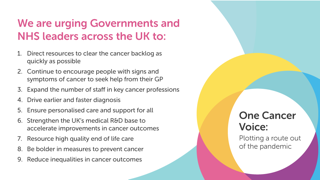One Cancer Voice charities come together to demand priorities for the route out of the pandemic for cancer services
We know that COVID has had a huge impact on certain elements of your brain tumour care, so together with the other charities in the One Cancer Voice coalition, we’re demanding that nine key issues are addressed as a priority.
Services can’t just be brought back to pre-pandemic levels – this is simply not enough.
From the One Cancer Voice statement:

We must go further and faster than ever before – so that the NHS can meet the rising demand of cancer incidence, adapt to the added pressure that COVID-19 will likely bring for years to come, and accelerate progress towards the UK’s cancer ambitions. This means rectifying the substantial workforce and equipment shortages that held the NHS back even before the pandemic. It means offering every person holistic care, recognising and supporting them with the wider needs sparked by their cancer diagnosis. It means investing in the power of research and innovation to drive us more quickly towards our ambitions. It means resourcing high quality end of life care for those who sadly need it. It means keeping the needs of a cancer patient woven into how health services are structured.
Main priorities for the brain cancer community
Expand the number of staff in key cancer professions:
We know there is a desperate shortage of radiologists; people’s brain scans are not being read as quickly as they could be. And this was before COVID, with a 35% gap that needed filling. These delays in scan reporting cause huge anxiety. The workforce has been fabulous during the pandemic, stepping up and being active in diagnosing and treating people with COVID, and those who needed urgent neurosurgery. Building a workforce for longer term is more needed than ever now, as services move to return to ‘normal’ rates of work, and we have a backlog of waiting patients and less capacity due to COVID-19. This needs proper planning; it isn’t a quick fix.
Ensure personalised care and support for all:
This needs to be done by meeting every cancer patient’s holistic needs, including appropriate mental health, wellbeing and practical interventions that improve people’s quality of life. This should include a holistic needs assessment, recognition of the unique needs of children and young people, personalised care and support plans, and signposting to wider information and support.
Treatment is only the beginning of the journey
Whilst brainstrust has kept going through the pandemic to help, we know that COVID-19 has forced many people to be more isolated and referrals to community services and charities have been harder to secure. It’s vital that people get access to support so they can reach their full potential post-diagnosis.
Read the full One Cancer Voice statement here. If you have any questions, or want to talk to us about how we can help you on your brain tumour journey – give us a call on 01983 292 405 or email hello@brainstrust.org.uk









